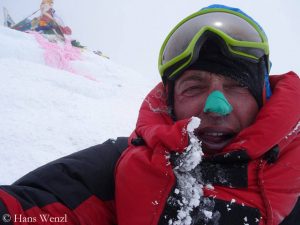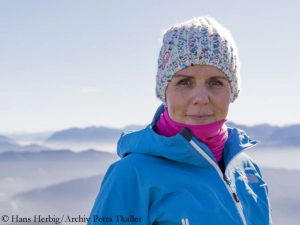Hard times for weather experts
“I’ve got some more gray hair,” said Karl, called “Charly” Gabl. “It was terrible.” The world-famous meteorologist from Austria was talking about the freak weather on Mount Everest during this spring season, which had made predictions as difficult as rarely before. Once again, Charly had pulled numerous all-nighters to advise top climbers from all over the world who trust him almost unconditionally. “The one computer model showed two and a half meters of fresh snow during a week, another one no precipitation. Which one should I take?”
Traditional good weather window stayed away
This year, there had been simply no longer period of good weather on Everest, the meanwhile 70-year-old told me when I met him last weekend at the trade fair “Outdoor” in the German town of Friedrichshafen. “Normally we have a few days in a row between 15 and 25 May without jet stream, with relatively high temperatures and best conditions, this time not. Instead cumulus clouds, in the morning sunshine, in the afternoon again and again precipitation.” How unpredictable the weather was this season, proved the last weekend of May: Eight climbers set off towards the summit without bottled oxygen. Only three of them reached the highest point without using breathing masks, in worse weather than predicted.
Father-to-children relationship
Nevertheless, he was satisfied with the balance of climbers he had been advising, said Gabl. Thus the blind Austrian climber Andy Holzer had reached the top of Everest, the German David Goettler had climbed through the Shishapangma South Face. “Tamara Lunger and Simone Moro were insofar successful that they did not have to make the Kangchenjunga traverse and returned home healthy.” Charly fears with the extreme climbers. “They’re friends. I have almost a father-to-children relationship to them. I look after them, I am happy if they are successful and stay healthy.”
Climate change says hi
Gabl is again advising some climbers during the current summer season on the eight-thousanders in Pakistan, among others on K 2, the second highest mountain on earth. Do the summit aspirants – like in the past years – have to reckon with high temperatures in the Karakoram? “I believe that the generally accepted climate warming, which Donald Trump has not yet noticed, does affect mountains and glaciers,” replied the meteorologist. “Rockfall has increased.” Gerlinde Kaltenbrunner and Ralf Dujmovits had already pointed out after their failed attempts on the Pakistani south side of K 2 some years ago that the Abruzzi Spur, actually the normal route, had become life-threatening, said Charly, adding that also the Cesen Route via the Southsoutheast Ridge, which was considered to be safer, “is meanwhile with all guns blazing. There is rock and icefall. The climate warming doesn’t stop at any mountains of the world.”










